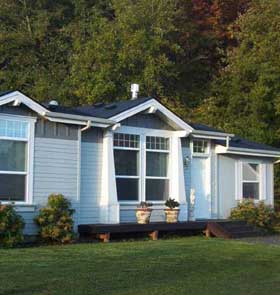News & Notes Archive - April 2008
The headline you don’t see: It’s a buyer’s market and manufactured homes take on more luster, especially as smart purchase options for placement on private land
Here in April 2008 the news from the mainstream housing front continues to be downbeat: home sales are down most everywhere; prices are inching lower; credit standards have tightened considerably; homes on the market are taking months to sell; and the full impact of the collapse continues to reverberate throughout the US economy. However, the flip side is, increasingly, this is a great time to buy a home. And, if the anecdotal evidence I have been seeing lately is any indication, a growing number of potential homebuyers around the nation are taking a good first look at manufactured housing as an option, and they like what they’re seeing.
I can see why. Despite the gloom over the housing market, manufactured homes (many still mistakenly call them “mobile homes”) stand out as an excellent product at a very competitive price and deserve consideration as a viable choice right along with site-built homes. Let me offer just one example, together with a few numbers:
Here’s a photo of a manufactured home that was sited on a small parcel in the Pacific Northwest several years ago.

Silvercrest Westwood series home, Craftsman style, w/ a 4/12 roof pitch
It’s a three-bedroom, two bath multi-section made by Silvercrest–about 1,500 square feet–with a distinctive Craftsman style appearance, Hardiboard siding and cinderblock skirting. With options such as skylights and glass sliding doors, its cost today (including delivery and set-up) would be around $90,000. That would make it a modest high end home.
Let’s say, in addition to site preparation and the foundation, you had to put in a well and a septic system. In rural Washington state, those costs would be something like:
| $20,000 | Grading, foundation slab, install gutters/skirting, connect water, utilities, waste lines |
| $4,000 | Put in a well |
| $8,000 | Construct a standard gravity septic system (tank and leach field) |
| $32,000 | Subtotal |
Together with the house, your total is $122,000. Add to this, say, $50,000 to purchase the land, and that gives you $172,000. To this add a two-car garage (either detached or attached): cost $15,000, and the grand total comes to $187,000 for a brand new, custom ordered three-bedroom, two-bath home.
Now, compare this number with $218,000, the median U.S. price for an existing single family home (and “existing” could mean the home is twenty or thirty years old and needing a remodel). You’ve saved $31,000–about 15%–and you’re moving into a new home with exactly the floor plan and options you want. Depending on the costs of land around the U.S. your savings may be even greater.
And the kicker is, if you order a 4/12 or higher roof pitch and attach your two-car garage, you will have a home that is virtually indistinguishable from a new site-built home. And that is why I call manufactured housing the best kept secret in American housing.
Champion closing down its Silverton, OR factory, producer of Redman Homes, with a loss of 160 full time jobs
In a move that reflects the continuing contraction of the manufactured home industry, Michigan-based Champion Enterprises, Inc., the nation’s second largest builder of HUD-code homes (Clayton Homes, Inc. is first), announced it will close its Silverton, Oregon production plant by May 23, costing 160 jobs. The move is strictly business-related, a Champion spokesperson claimed. Altogether, Champion operates about 35 manufacturing facilities around the country, building manufactured and, modular homes, including institutional structures such as military barracks and commercial buildings.
These are tough times for the MH industry in the Northwest. Last fall, Fleetwood Homes idled its Woodland, OR plant, costing 135 jobs, some of which were absorbed by allowing workers to transfer to Fleetwood’s other plant in Woodburn, OR.
Oregon has seven other manufactured-home factories. Homebuilders Northwest (in Salem), Golden West Homes (Albany), Karsten Homes (Stayton), Liberty Homes (Sheridan), Palm Harbor Homes (Millersburg), Marlette Homes (Hermiston) and Fuqua Homes (Bend).
Interview: 15 minutes with...Bruce Savage
Note: In my role as an industry observer and consumer advocate I speak with people at all levels of the manufactured home industry (MH) to gain insights I share with my readers to help them be better informed. Some I have interviewed for a one-page column that runs in an industry trade publication. In return the magazine runs an ad for the Grissim Guides. No money changes hands. I insist on this. Aside from book sales, I neither solicit nor accept a dime from the industry, and my readers have my assurance I intend to keep it that way. Here’s this month’s interview:

Bruce Savage, former director of communications for the Virginia-based industry trade association Manufactured Housing Institute and ex-publisher of Modern Homes magazine
Background: Age 57. Born in Rocky Mount, NC and raised in the small town of Tarboro, NC (“In the state’s eastern rural, agrarian region–I had a wonderful small-town upbringing there, an idyllic American scene.”) His father was a commercial pilot, his mother a pediatric psychotherapist and part-time college professor. After high school (graduating in ’68), briefly attended Davidson College before transferring to University of North Carolina (Chapel Hill), majoring in journalism and political science. “This allowed me to be closer to my only sibling, my younger brother who had been diagnosed with leukemia. He was 16 when he died, a life-altering moment for me.” Savage took an 18-month break from studies to recuperate, taking a low-budget trek through Europe (“I loved Europe and it confirmed my philosophy to live in the moment and enjoy life because you never know what’s around the corner.”) Returning to the U.S. and graduating from UNC in ’74, worked for two years as a reporter for the Charlotte Observer before relocating to D.C., briefly attending American University for post-grad work and beginning a career in corporate communications at The Riggs National Bank (“We were right across from the White House and advertised ourselves as The Bank of the Presidents – so many had their accounts there.”)
In ’88, accepted a similar position at the trade group, American Gas Association, stayed there three years before being recruited in ’91 by MHI just as the 90s MH boom was starting. “I attribute the industry’s take-off to my coming aboard (laughs). I totally deny I had anything to do with the downturn.” In January, Savage departed MHI to become Vice President of Communications for the D.C.-based Institute of Scrap Recycling Industries (“I’ve moved from trailer trash to trash”). Savage’s partner of 30 years, Irv Stedman, is a financial planner specializing in estate planning.
- Q: Looking back, what were your most rewarding experiences during your 16 years at MHI?
- A: Two things come immediately to mind: one was in the late-90s when we worked with Miss America, Heather French, on a Homeless Vets Program, as part of her charity work. The undertaking was particularly rewarding and successful in spotlighting the MH industry. More recently was MHI’s Gulf Coast Housing Initiative after Hurricanes Katrina and Rita, where MHI held a series of meetings throughout the region to showcase for public and non-profit officials what factory-built housing could really do to help put people back in homes. In both these instances, the industry stepped outside itself and played a really positive role in the world and society. It was personally very rewarding.
- Q: What was your most vexing challenge day to day?
- A: Getting the industry’s sectors to move beyond their parochial interests and find common ground–which is certainly there–and work together strategically, realizing they’re all in this together. They never seemed to get that. Instead they seemed more focused on reacting to situations after-the-fact.
- Q: You spent years advocating a national image campaign. Was the industry’s failure to implement one a major disappointment?
- A: I’d say so, yes. There was this major disconnect. The industry hired Roper Associates and J.D. Power, both who confirmed the public’s poor perceptions, and told us it made no sense to do a national marketing campaign until we first cleaned up our act internally, on issues such as our sales and lending practices, installation, warranty service and customer satisfaction. But very little happened. The manufacturers seemed afraid of their dealers, willing to let them do anything as long as the orders kept coming, to keep their parking lots full. That’s a recipe for disaster.
- Q: With the image campaign apparently on the back burner, Clayton Homes is about to launch its own national branding campaign. Your thoughts?
- A: The manufacturers continue to see each other as their major market competition and spend their resources on branding. But there’s a larger problem that’s not being addressed...the underlying image of manufactured housing as inherently inferior, necessity housing. My attitude was, “If you want to be a player in the housing market, you’ve got to appeal to new markets, grow the pie. Instead of 300,000 home sales in a great year, why not a half million? Or a million? The industry has all these advantages, yet there has always been a self-defeatist attitude, like, “We’ll always be secondary, so our competition is each other.”
- Q: If you could wave a magic wand?
- A: I’d insist on accountability and responsibility, top to bottom. I’ve never understood why a manufacturer would invest so much to perfect a product, then as soon as a home leaves the factory, say, “Okay, that’s it, I’m no longer in charge.” Look, if I were a manufacturer, I’d insist my retailers display and sell my homes properly, or lose their franchise. As for unethical behavior, those problems stem from the lack of accountability, which creates the mind set “There’s nobody monitoring me so I can do what I want.” If I were a Ford dealer and treated people that way, and Ford found out about it, they’d yank my franchise in a heartbeat. But that’s rare in this industry.
- If companies were smart they’d provide the consumer with a written pledge that, in addition to coverage by an extended warranty, says “Our customer service promises that any problems you encounter will be handled promptly with just one phone call–one phone call and one answer.” Figure out internally how best to solve the problem, but keep it simple for the customer, and deliver on promises. So, manufacturers would have to add $100 per floor to cover that level of service. Not a big deal. But with very few exceptions, it hasn’t happened.
- Q: You mention having worked with some remarkable people
- A: I have. The list is long. Just a few: Ray Broderick, a phenomenal Pennsylvania retailer; Joan Brown, the driving force behind the Northwest Pride campaign; Charlotte Gattis, the Georgia trade association exec who’s retiring and who did so much for the industry; and the staff at MHI who work so hard with limited resources to make industry events, such as the Las Vegas Expo, a success year after year. I’ll miss them all.